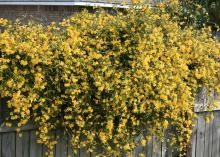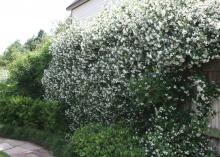Information Possibly Outdated
The information presented on this page was originally released on May 11, 2015. It may not be outdated, but please search our site for more current information. If you plan to quote or reference this information in a publication, please check with the Extension specialist or author before proceeding.
Plant flowering vines now for great show next spring
If you’re looking for something for your landscape that you’ve never tried, may I suggest flowering vines. Many gardeners enjoy these plants but don’t really give them enough attention except when they’re blooming in the spring.
Two of my favorite flowering vines are yellow jasmine and Confederate jasmine.
I like these two vines because their beautiful flowering does not compete with each other. Yellow jasmine is one of the very first bloomers in early spring, so it is long finished while the confederate jasmine is still putting on a show for at least a couple more weeks.
Yellow jasmine, also known as yellow jessamine, adds one of the first touches of color after winter and, in my opinion, is a good predictor of spring’s rising temperatures. This plant is native all over the Southeast in hardiness zones 7 to 10.
Botanically speaking, yellow jasmine is not a true jasmine as you would infer by its common name. The bright, clear yellow flowers are displayed in clusters, making it easy to understand the origin of the common name. Individual yellow jasmine flowers are funnel shaped and can be more than 1 inch in length and diameter. On calm days, it’s easy to enjoy its sweet fragrance.
The evergreen foliage is narrow and oblong and is a dark, glossy green. Each of the leaves ends with a slender pointed tip. The leaves are paired opposite each other on the brownish-sienna stems. Yellow jasmine can be trained as an evergreen, dense and compact climber for a sunny trellis. This is a perfect way to bring the beautiful flowers up to eye level for a closer examination.
Regardless of its name and the fact that it is widely grown throughout the South, Confederate jasmine is neither a Southern native nor a true jasmine. It is an import from China that is hardy in zone 8 in Mississippi. It also goes by the common moniker of star jasmine.
This plant begins flowering by midspring and continues through early summer, producing clusters of small white flowers with twisted petals that resemble tiny pinwheels. Even though the individual flowers are pretty small, their prodigious numbers produce a fragrant punch as you pass by.
Confederate jasmine is a fairly fast-growing vine that can be trained to cover a trellis or wall and scramble up lampposts and pillars. This vine tolerates pruning very well; in fact, regular pruning keeps the foliage tight and looking tidy. Be sure to prune after flowering as the flower buds are set on last year’s growth. This is one of the few plants for which I consider the use of pruning shears to be an appropriate way to trim it. Time your pruning similar to when you prune landscape azaleas.
While we’re past the time to enjoy these flowering vines this year, now is the perfect time to plant for flowering next spring. Plant in a well-drained landscape bed or even a large container near a landscape structure for the vines to climb. Fertilize at planting and maintain consistent moisture this year.
Next spring, you will be ready to enjoy a beautiful, two-part show from these flowering vines.









